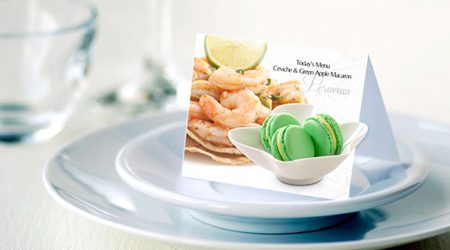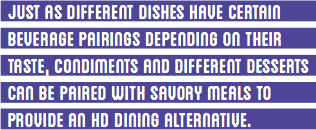
The entire world has gone gourmet. The “foodie” movement is growing and reaching new heights in all corners of the world. More and more people are embracing the idea of making food and experience – taking note of flavors, textures, aromas, and ingredients in everyday foods and beverages. Beer microbreweries have blossomed because consumers were itching for superior quality and taste. Consumers are ready to put aside the traditional and insipid food and beverage options that had dominated the market for decades and are now opting for more gourmet alternatives with bold flavors and innovative combinations.
As today’s dining experience continues to develop, chefs around the world aren’t afraid to put on a show for their clients with new ingredients or groupings. Although alcoholic beverages and entrees have always been paired to enhance the dining experience, it’s time for desserts to step up to center stage and play the most important role. It’s logical since they are the show’s final act – the last opportunity to wrap up an unforgettable sensory experience for the consumer’s palate.
Just as different dishes have certain beverage pairings depending on their taste, condiments and different desserts can be paired with savory meals to provide an “HD” dining alternative. For example, it’s quite common for a red wine to complement a tender beef steak – the drink is supposed to be an extension of the meal and not take away from it. Author Colleen Graham suggests in her article “How to Pair Cocktails and Food” matching bold flavors with subtle foods and vice versa. For instance, restaurants would pair a soft-flavored duck or fish with a strong, flavor-filled cocktail. On the other hand, a spicy Asian dish would go better with a light, airy, refreshing cocktail. The same logic applies when pairing desserts with meals – the strength and characteristics of the ingredients should be accounted for. It would make more sense for sushi to be followed with subtle and delicate green tea gelato rather than a rich chocolate cake, for instance.
Furthermore, wines and cocktails can complement desserts, so instead of serving coffee with a dessert course, a dessert wine is a great alternative. rich chocolate desserts go well with red wines such as Shiraz or Grenaches. For light buttery pastry, a white riesling should do the trick. While Champagne is the classic wine choice for parties and celebrations, it’s also a very versatile drink. Champagne and other sparkling wines – such as Prosecco – are ideal for pairing with desserts since most bottles are blended with different vintage wines, resulting in a drink that’s greater than the sum of its parts. An article by Chris Hallowell, on epicurious.com, furthers that wine is a great pairing for desserts by sharing they also tend to showcase minerality, a characteristic that adds depth to fruity flavors and also acidity that cuts through rich-fatty dishes.
“Foodies” very often describe dining as an enhanced experience – just as there are movies,TV and music in High Definition (HD) – dining has the potential to reach a new level and become HD too. The goal of desserts should be to provide this experience to the consumers’ palates. Different cuisines around the world demand different alternatives. Just as we looked at different food-wine and dessert-wine pairings, savory meals around the world have an ideal dessert match that will wrap up the dining experience like no other. Let’s start by taking a look at Argentine cuisine, where steak and wine seems to be a constant feature. Traditionally, vegetables and spices are far less employed in comparison to other cuisines around the world.
An “Asado,” grilled steak, can be paired with the national red wine – Malbec. To wrap up this dining experience, a forest berries gelato would be ideal. Furthermore, Malbec red wine could be infused into this frozen treat to please the palate after the meal since it would bring a sweet-yet-familiar taste to finish. To innovate and surprise even more, add a twist to the traditional Argentinian dessert Dulce de Leche, a confection prepared by slowly heating sweetened milk, by layering it with pannacotta to create an original dessert that resonates with the local cuisine.
Continuing through South America, we can find one of the highest trending cuisines around the world – Peruvian food. Although it’s impossible to encapsulate this cuisine in a couple of dishes because of its diversity, “Ceviche” is probably at the forefront when we take a deep look. Ceviche is basically raw fish cooked with lime juice and seasoned with onion, garlic and other spices. Seafood and lime can be tricky for a dessert to follow; however, a green apple macaron would be a great way to conclude the meal because of its slightly sour, yet crisp flavor.
Next stop is Indian cuisine. Since traditional dishes such as curry are heavily spiced, simple and refreshing options should be part of the dessert menu. remember the last time you had a taste for Indian food? Chances are that your taste buds were overwhelmed with spices and hotness. It’s not uncommon for your body to even break a sweat while you eat a spicy curry! A lemon gelato or sorbetto would be ideal to clean and refresh the palate while providing a sweet and slightly acid touch to restore body and mind. Furthermore, a raspberry lemon macaron would also provide a revitalizing finish with a more sophisticated touch.
As we continue to review cuisines around the world, we move east to Japan, where sushi, the national dish, can be found practically everywhere in the world. Just as with Peruvian food, following a fish entrée can be challenging. However a subtle green tea or green mint gelato would complement sushi spectacularly. To further innovate, dessert sushi has begun trending in high-end cuisine and pastry can substitute for the ingredients with refreshing tastes and innovative textures.
Let’s quickly change our focus to Europe, a continent with a rich culinary tradition. Italian food possibly ranks as the top cuisine in the world. Pastas and meats are a constant feature, and while traditional gelato flavors such as chocolate would be great to follow the different entrées, a bold flavored coffee frozen treat would provide a higher dining experience. However, the ideal aperitif would be an affogato – a scoop of gelato bathed in a shot of espresso.
Just across the Italian northwestern border we enter France, responsible for some of the best pastry in the world and also some of the richest and most tasteful cuisines. Traditional dishes like ratatouille or escargot could be complemented with a cherry pannacotta verrine or sour cherry brownies. Moving west, we find ourselves in Spain, where paella is one of the most important dishes.There are three widely known types of paella: Valencian paella, seafood paella and mixed paella, but there are many others as well. Valencian paella consists of white rice, green vegetables, meat, land snails, beans and seasoning. Seafood paella replaces meat and snails with seafood and omits beans and green vegetables. Mixed paella is a free-style combination of meat, seafood, vegetables, and sometimes beans. Some key ingredients include saffron and olive oil. Since most paella is heavily spiced, a simple but still refreshing pomegranate layered verrine is a natural pairing. “Granada” is the Spanish word for pomegranate and is a common fruit in Spain, as it is around the Mediterranean. Spain is one of the major producers of this round fruit that grows on trees and a dessert that utilizes it is a natural coupling for any paella.1 Dessert shops such as gelaterias and patisseries can capitalize on this gourmet trend by examining the area and demographics of their location. Your shop may be located next to a Japanese restaurant, or you may even be able to build mutually beneficial relationships with restaurants, hotels and casinos that offer different ethnic entrees on their menus. As long as you are able to take into account the flavor profile and ingredients of the main dishes being offered, you can couple them with their ideal dessert match, and make additional sales through wholesale. Many restaurants would prefer to buy their desserts due to not being able to bring on a pastry chef.
At the end of the day, food and drinks have been paired for decades. However, as consumers become more knowledgeable about flavor profiles and how they interact with each other, it’s inevitable for desserts to enter the picture and be sought for finishing the dining experience on a high note. No other part of the menu has the potential to make a bigger impression than the dessert, since it’s the last food that is tasted. The world is going gourmet and the dining experience has become an HD experience for many. It’s time for desserts to be part of a bigger and more integral offering that could give the word gourmet a whole different meaning.
Resources and Further Reading:
1 Sierra T. Pomegranates – Granadas A fruit loved throughout history Retrieved February 8, 2013 from http://spanishfood.about.com/od/essentialingredients/a/
pomegranates.htm
Graham C. How to Pair Cocktails with Food. Retrieved February 6, 2013 from
http://cocktails.about.com/od/foodbeveragepairing/a/cocktail_pairing.htm
Hallowell C. Champagnes and Sparkling Wines for More Than Just the Holidays 10 top bottles for any occasion, plus sweet and savory food pairings for bubbly. Retrieved February 6, 2013 from http://www.epicurious.com/articles- guides/drinking/wine/champagne-sparkling-wine-food-pairings
Noli D. Argentine Food: Steak, Empanadas, Pizza, Pasta, Repeat. Retrieved August 18, 2013 from http://www.uncorneredmarket.com/2010/08/argentine-food-steak- empanadas-pizza-pasta/

